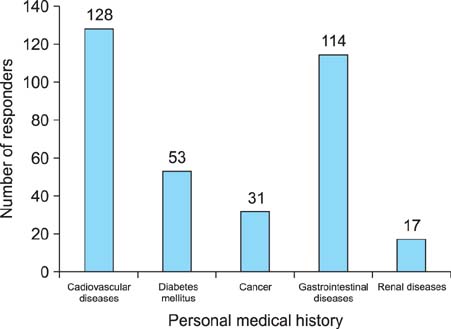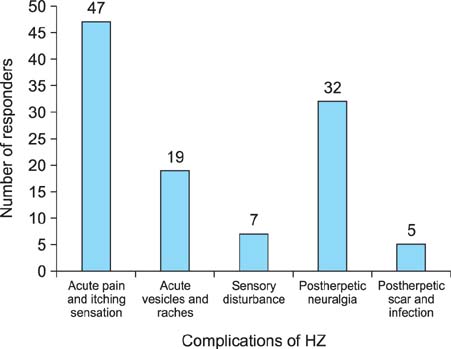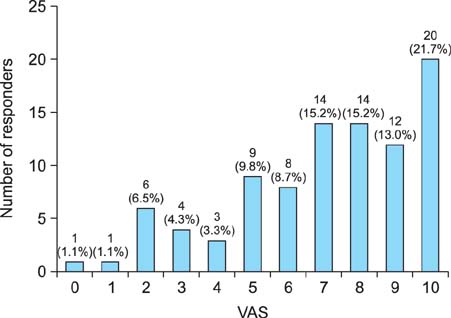Ann Dermatol.
2015 Oct;27(5):531-538. 10.5021/ad.2015.27.5.531.
Awareness, Knowledge, and Vaccine Acceptability of Herpes Zoster in Korea: A Multicenter Survey of 607 Patients
- Affiliations
-
- 1Department of Dermatology, Konkuk University School of Medicine, Seoul, Korea. 20050078@kuh.ac.kr
- 2Department of Dermatology, Seoul St. Mary's Hospital, College of Medicine, The Catholic University of Korea, Seoul, Korea.
- 3Department of Dermatology, St. Paul's Hospital, College of Medicine, The Catholic University of Korea, Seoul, Korea.
- 4Department of Dermatology, Inha University School of Medicine, Incheon, Korea.
- 5Department of Dermatology, Chung-Ang University College of Medicine, Seoul, Korea.
- 6Research Institute of Medical Science, Konkuk University, Seoul, Korea.
- 7Department of Dermatology, Kyung Hee University School of Medicine, Seoul, Korea.
- KMID: 2171453
- DOI: http://doi.org/10.5021/ad.2015.27.5.531
Abstract
- BACKGROUND
Herpes zoster (HZ) infection can significantly impair the quality of life of the affected individuals, and its treatment imposes a considerable cost burden on the health-care system and on society at large. However, there is little information on the perception of this disease and the acceptability of vaccines in Korea.
OBJECTIVE
The aim of this study is to determine the awareness of HZ and its vaccine, and to identify factors associated with the acceptability of the HZ vaccine among outpatients of dermatology clinics.
METHODS
A questionnaire-based survey was conducted on 607 outpatients who visited the dermatologic clinics.
RESULTS
The responses of the patients revealed a high awareness of HZ (85.4%) but a relatively low knowledge about HZ and its vaccine (42.3%). The HZ vaccination rate among patients aged > or =50 years was 9%. A history of HZ infection, being older, and greater knowledge about HZ and its vaccine were associated with a higher HZ vaccine acceptability. Of those who had not been vaccinated, 58.3% were interested in receiving the vaccine. The most frequent reason for this interest was "severe sequelae," followed by "knowing someone who has HZ" and "recommendation from a doctor." High cost was the most common reason for unwillingness to receive the vaccination.
CONCLUSION
Despite a high awareness of HZ, vaccine acceptability was extremely low among this study cohort. Vaccination acceptability would be improved by encouraging doctors to educate elderly patients about the disease and the availability of vaccination, and by the provision of insurance coverage for HZ vaccination.
Keyword
MeSH Terms
Figure
Cited by 1 articles
-
A Study of Intravenous Administration of Vitamin C in the Treatment of Acute Herpetic Pain and Postherpetic Neuralgia
Min Sung Kim, Dong Jin Kim, Chan Ho Na, Bong Seok Shin
Ann Dermatol. 2016;28(6):677-683. doi: 10.5021/ad.2016.28.6.677.
Reference
-
1. Langan SM, Smeeth L, Margolis DJ, Thomas SL. Herpes zoster vaccine effectiveness against incident herpes zoster and post-herpetic neuralgia in an older US population: a cohort study. PLoS Med. 2013; 10:e1001420.
Article2. Oxman MN, Levin MJ, Johnson GR, Schmader KE, Straus SE, Gelb LD, et al. Shingles Prevention Study Group. A vaccine to prevent herpes zoster and postherpetic neuralgia in older adults. N Engl J Med. 2005; 352:2271–2284.
Article3. Gilden DH. Varicella-zoster virus vaccine--grown-ups need it, too. N Engl J Med. 2005; 352:2344–2346.4. Hurley LP, Harpaz R, Daley MF, Crane LA, Beaty BL, Barrow J, et al. National survey of primary care physicians regarding herpes zoster and the herpes zoster vaccine. J Infect Dis. 2008; 197:Suppl 2. S216–S223.
Article5. European Medicines Agency. ZOSTAVAX Product Information [Internet]. c2013. cited 2013 Mar 27. Available from: http://www.ema.europa.eu/docs/en_GB/document_library/EPAR_-_Product_Information/human/000674/WC500053462.pdf.6. Hensley S. NPR. FDA gives OK to broader use of shingles vaccine [Internet]. Available from: www.npr.org/blogs/health/2011/03/25/134849776/zostavaxfda-gives-ok-to-broader-use-of-shingles-vaccine.7. Weinberg JM. Herpes zoster: epidemiology, natural history, and common complications. J Am Acad Dermatol. 2007; 57:6 Suppl. S130–S135.
Article8. Brisson M, Edmunds WJ, Law B, Gay NJ, Walld R, Brownell M, et al. Epidemiology of varicella zoster virus infection in Canada and the United Kingdom. Epidemiol Infect. 2001; 127:305–314.
Article9. Russell ML, Schopflocher DP, Svenson L, Virani SN. Secular trends in the epidemiology of shingles in Alberta. Epidemiol Infect. 2007; 135:908–913.
Article10. Pérez-Farinós N, Ordobás M, García-Fernández C, García-Comas L, Cañellas S, Rodero I, et al. Varicella and herpes zoster in Madrid, based on the Sentinel General Practitioner Network: 1997-2004. BMC Infect Dis. 2007; 7:59.
Article11. Chao DY, Chien YZ, Yeh YP, Hsu PS, Lian IB. The incidence of varicella and herpes zoster in Taiwan during a period of increasing varicella vaccine coverage, 2000-2008. Epidemiol Infect. 2012; 140:1131–1140.
Article12. Choi WS, Noh JY, Huh JY, Jo YM, Lee J, Song JY, et al. Disease burden of herpes zoster in Korea. J Clin Virol. 2010; 47:325–329.
Article13. Toyama N, Shiraki K. Society of the Miyazaki Prefecture Dermatologists. Epidemiology of herpes zoster and its relationship to varicella in Japan: a 10-year survey of 48,388 herpes zoster cases in Miyazaki prefecture. J Med Virol. 2009; 81:2053–2058.
Article14. Drolet M, Brisson M, Schmader KE, Levin MJ, Johnson R, Oxman MN, et al. The impact of herpes zoster and postherpetic neuralgia on health-related quality of life: a prospective study. CMAJ. 2010; 182:1731–1736.
Article15. Chidiac C, Bruxelle J, Daures JP, Hoang-Xuan T, Morel P, Leplège A, et al. Characteristics of patients with herpes zoster on presentation to practitioners in France. Clin Infect Dis. 2001; 33:62–69.
Article16. Oster G, Harding G, Dukes E, Edelsberg J, Cleary PD. Pain, medication use, and health-related quality of life in older persons with postherpetic neuralgia: results from a population-based survey. J Pain. 2005; 6:356–363.
Article17. Weinke T, Edte A, Schmitt S, Lukas K. Impact of herpes zoster and post-herpetic neuralgia on patients' quality of life: a patient-reported outcomes survey. Z Gesundh Wiss. 2010; 18:367–374.
Article18. Schmader K, Gnann JW Jr, Watson CP. The epidemiological, clinical, and pathological rationale for the herpes zoster vaccine. J Infect Dis. 2008; 197:Suppl 2. S207–S215.
Article19. Bouhassira D, Chassany O, Gaillat J, Hanslik T, Launay O, Mann C, et al. Patient perspective on herpes zoster and its complications: an observational prospective study in patients aged over 50 years in general practice. Pain. 2012; 153:342–349.
Article20. Javed S, Javed F, Mays RM, Tyring SK. Herpes zoster vaccine awareness among people ≥50 years of age and its implications on immunization. Dermatol Online J. 2012; 18:2.21. Lee TJ, Hayes S, Cummings DM, Cao Q, Carpenter K, Heim L, et al. Herpes zoster knowledge, prevalence, and vaccination rate by race. J Am Board Fam Med. 2013; 26:45–51.
Article22. Kawai K, Preaud E, Baron-Papillon F, Largeron N, Acosta CJ. Cost-effectiveness of vaccination against herpes zoster and postherpetic neuralgia: a critical review. Vaccine. 2014; 32:1645–1653.
Article
- Full Text Links
- Actions
-
Cited
- CITED
-
- Close
- Share
- Similar articles
-
- A Survey of the Awareness, Knowledge, and Vaccine Acceptability of Herpes Zoster in Dermatologic Outpatients of University Hospital
- Physician Attitudes toward the Herpes Zoster Vaccination in South Korea
- Herpes zoster vaccine in Korea
- Herpes zoster ophthalmicus after COVID-19 vaccine booster in healthy younger adult: a case report
- What is Different about Recombinant Herpes Zoster Vaccine?




